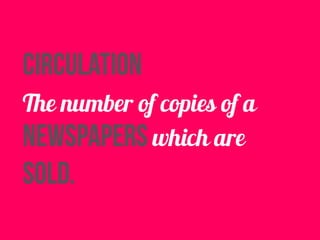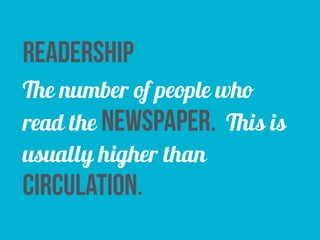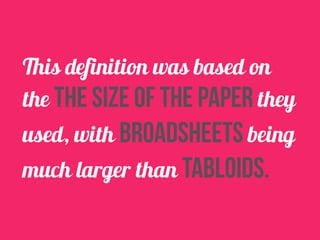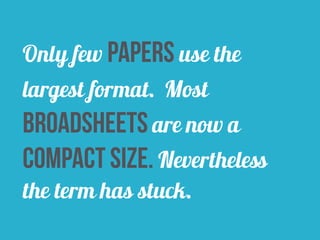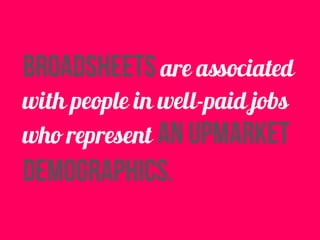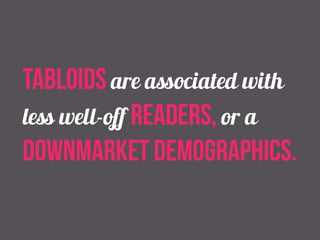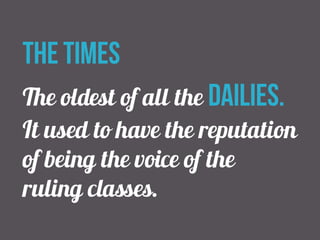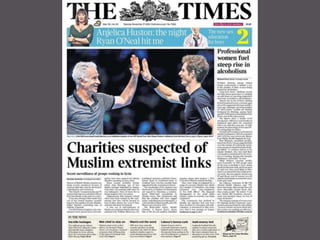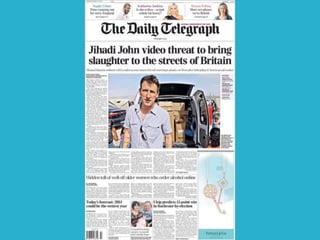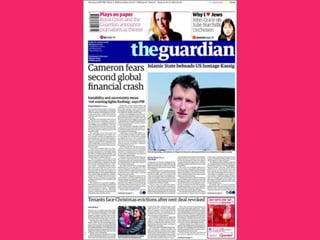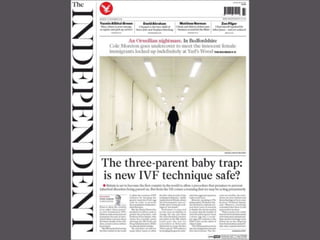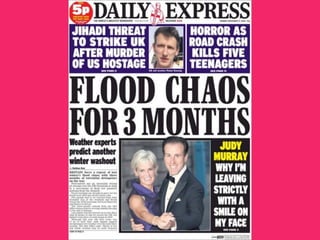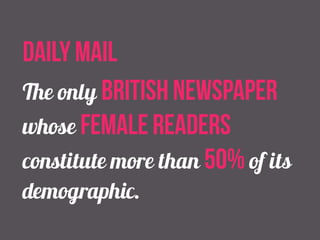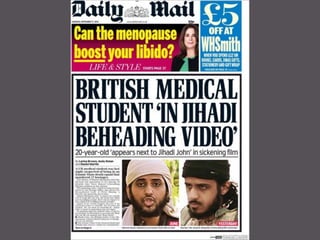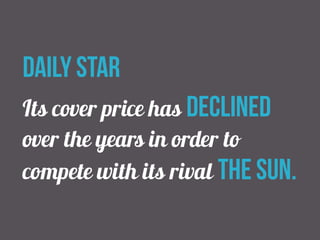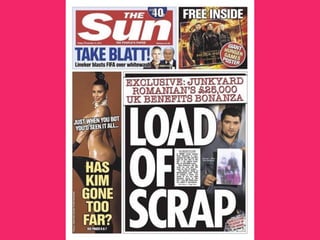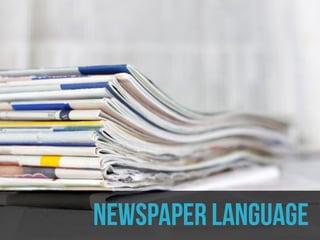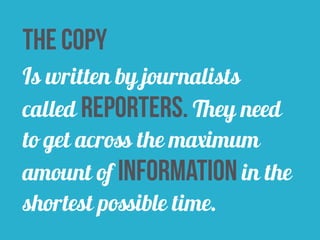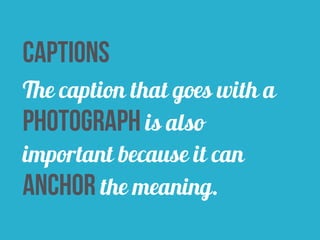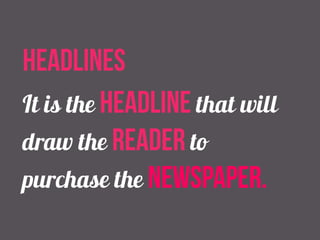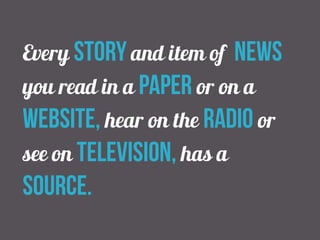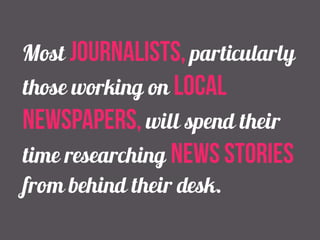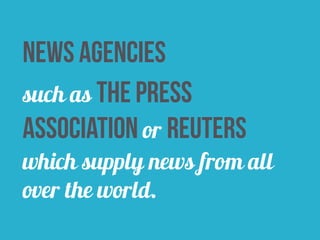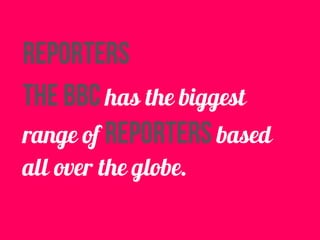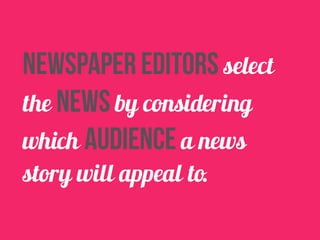11. Newspapers
- 1. newspapers
- 3. one Identify different types of newspapers and their target audiences.
- 4. two Understand how audiences are targeted and retained by media organisations.
- 5. three Know different codes and conventions used by media organisations.
- 6. four Understand the changes in media brought by technology.
- 8. circulation The number of copies of a newspapers which are sold.
- 9. readership The number of people who read the newspaper. This is usually higher than circulation.
- 10. There are two main types of newspapers. They are divided into broadsheets and tabloids.
- 11. This definition was based on the the size of the paper they used, with broadsheets being much larger than tabloids.
- 12. Only few papers use the largest format. Most broadsheets are now a compact size. Nevertheless the term has stuck.
- 13. There are also generalisations about who reads each sort of paper which are based on audience research.
- 14. broadsheets are associated with people in well-paid jobs who represent an upmarket demographics.
- 15. tabloids are associated with less well-off readers, or a downmarket demographics.
- 16. broadsheets Newspapers printed in a large format. They are considered to be more serious in content than tabloids.
- 17. broadsheets have higher news content, usually higher prices for each copy and lower circulation figures than tabloids.
- 18. the times The oldest of all the dailies. It used to have the reputation of being the voice of the ruling classes.
- 20. The daily telegraph Is the broadsheet with the highest circulation. It is a supporter of the Conservative Party.
- 22. the guardian Is usually described as a liberal or left-wing paper.
- 24. the independent Is the newest of all the dailies and intended to be independent of any one political party’s view.
- 26. the financial times Is the only national daily to be printed on pink paper. It reports mainly on business and economic news.
- 28. tabloids Newspapers with pages half the size of broadsheets. They are usually more highly illustrated.
- 29. daily express One of the first papers to feature gossip, sports and women’s articles. It was also the first newspaper in Britain to have a crossword.
- 31. daily mail The only British newspaper whose female readers constitute more than 50% of its demographic.
- 33. daily mirror Originally aimed at the middle class reader, it was converted into a working class newspaper to reach a larger audience.
- 35. daily star Its cover price has declined over the years in order to compete with its rival the sun.
- 37. the sun Has the largest circulation of any daily newspaper in the united kingdom.
- 40. the language of a newspaper is not just words that appear in them.
- 41. It includes pictures that are used, different font styles and sizes in text and headings, and the layout of the page.
- 42. the copy Is written by journalists called reporters. They need to get across the maximum amount of information in the shortest possible time.
- 43. the pictures Photographs play an important part in the whole look of a newspaper, especially the front page.
- 44. captions The caption that goes with a photograph is also important because it can anchor the meaning.
- 45. captions They try to push the reader towards one angle by providing an interpretation for them.
- 46. headlines It is the headline that will draw the reader to purchase the newspaper.
- 47. layout When all the copy is written and all photographs have been chosen, the final layout of the front cover can then be decided.
- 48. the news selection process
- 49. Every story and item of news you read in a paper or on a website, hear on the radio or see on television, has a source.
- 50. In an age of 24-hour rolling news, it is easy to imagine that all news journalists rush around the globe, chasing action-packed stories.
- 51. Most journalists, particularly those working on local newspapers, will spend their time researching news stories from behind their desk.
- 52. journalists get their stories from a variety of sources:
- 53. news agencies such as the press association or reuters which supply news from all over the world.
- 54. reporters the bbc has the biggest range of reporters based all over the globe.
- 55. reporters The smaller the organisation, the fewer reporters there are to cover events.
- 56. from each other Foreign television, the national press and radio all provide stories.
- 57. freelance journalists may approach A newspaper with a story, or may be commissioned to research one.
- 58. processed news This is gathered from items such as press releases, police and local authorities.
- 59. With so many sources of news, there are far more stories that can be included in the papers.
- 60. newspaper editors select the news by considering which audience a news story will appeal to.







